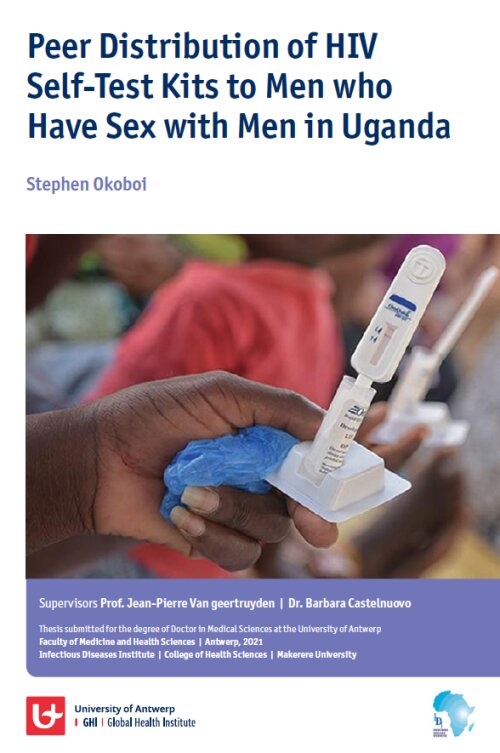Peer Distribution of HIV Self-Test Kits to Men who have Sex with Men in Uganda
Background

HIV self-testing (HIVST), a process by which a person performs an HIV test on himself or herself to know their HIV sero-status, is an accessible evidence-based self-controlled tool that can empower MSM to overcome healthcare stigma and discrimination, and increase access to HIV testing. Peer delivered HIV self-testing through MSM networks could be synergistic to existing HIV prevention programs in a high-burden population unconnected to conventional health systems. Combining HIVST with peer network delivery offers a unique opportunity to reach MSM with user-friendly technology in their community. However, these strategies have not been combined to extend the reach of HIV testing services into African MSM social and sexual networks, and no study has estimated the cost and cost-effectiveness of peer delivery of HIVST kits in Sub-Saharan Africa.
In this thesis, we examine i) acceptability of HIVST, 2) preliminary effectiveness of the MSM peer HIVST kit distribution, 3) the cost and cost-effectiveness of the peer HIVST kit distribution compared to standard of care HIV testing among MSM.
We used:
A qualitative design to assess acceptability of HIVST for objective 1, a non-randomized study for objective 2, and 3) the provider perspective for objective 3
Key results
We observed that peer-delivered HIV self-testing in MSM networks was highly acceptable. MSM participants further described HIV self-testing as a mechanism that would facilitate the uptake of HIV testing in a rapid, efficient, confidential, non-painful, and non-stigmatizing manner. Out of 297 participants included in the non-randomized study, 150 received HIVST (intervention) and 143 received standard of care HIV testing within three months. We observed that 95% of the MSM completed HIVST, of which 32% had never tested for HIV, while 100% completed SOC testing. A total of 12 participants were diagnosed with HIV: eight in the intervention arm, and four in the SOC group [5.6% versus 2.7%, respectively; P=0.02]. Overall, the MSM peer strategy resulted in higher HIV positivity yield (4.9% vs. 1.4%) and averted more HIV infections per year (0.364 vs. 0.104) compared with SOC. The incremental cost per HIV transmission averted by the self-testing program was $1,727. The incremental cost to providers per additional HIV-positive person identified by the intervention was $112.3.
Conclusions
The distribution of HIVST kits by MSM peers is an acceptable strategy that can promote access and uptake to HIV testing. Peer distribution of HIVST through MSM networks is feasible, effective, diagnoses more new HIV infections than SOC approach. Using a cost‐effectiveness threshold set at US $2,129.10, peer distribution of HIVST kits was cost-effective, averted more HIV transmissions and identified more undiagnosed HIV infections than SOC hotspot testing.